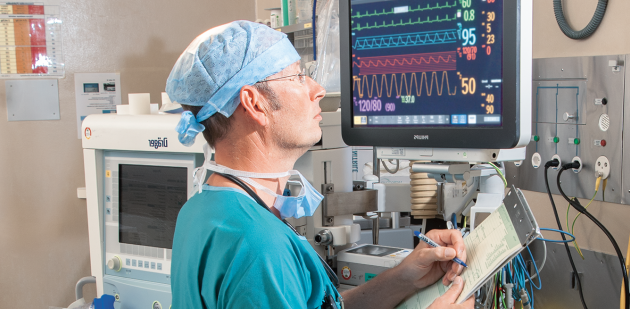Equipped with their wireless sensors, Patrick Schoettker and Josep Solà hope to revolutionise the way things are done in the operating room.

The operating room could be entering a new era of wireless monitoring. Those cumbersome cables attached to devices, long used to measure patients’ physiological data, could soon be replaced by high-precision, autonomous sensors. Electrodes secured to the skin determine the patient’s blood pressure, electrocardiogram, oxygen saturation, respiratory rate and body temperature, all in real time. These innovative adhesives could then send the data collected to the tablets used by health care staff via Bluetooth. Not only would that mean shedding some of the bulk of monitoring equipment, but it would also make things easier for anaesthetists.
That is the goal of the partnership between Patrick Schoettker, head physician in clinical research at the Anaesthesiology Service at the Lausanne University Hospital (CHUV), and Josep Solà, an engineer from the Swiss Centre for Electronics and Microengineering (Centre Suisse d’Electronique et de Microtechnique or CSEM). The project set up by the doctor-engineer team is financed by their respective institutions and was rapidly given the green light by Swissmedic and Swissethics. An initial set of tests carried out on about 40 patients, to compare the measures taken by traditional equipment based on calibrated standards with those taken by the wireless sensors, produced results that exceeded the duo’s wildest expectations. “We’re still in the analysis phase, but the prototypes come closer to actual data than equipment reputed for being extremely reliable,” says Schoettker. “Placed strategically, the sensors pick up signals down to the nanosecond!”
The CSEM has been developing this technology for many years. “We began designing sensors for astronauts with the European Space Agency in 2004. Our research was then applied to develop smart clothing for sports before being adapted to biomedical solutions,” says Josep Solà. A chance encounter with Patrick Schoettker offered the opportunity to optimise the system. “A number of frustrating issues in current medical practice can be solved by engineers,” the doctor says.
“We need to explore these synergies further.” (Read the full report in “In Vivo” 9). This form of monitoring has proved its worth in the operating theatre, but Dr Schoettker remains cautious. “This environment is ideal for these types of measures. But, for example, we don’t know how the adhesives react in natural light,” he says in discussing potential development, such as monitoring patients in outpatient care. Precaution aside, the partners are sure that these sensors could be applied to other needs in the future, such as measuring cardiac output. “The technology offers real economic potential, but we have to wait for hard data before bringing the device to market.”